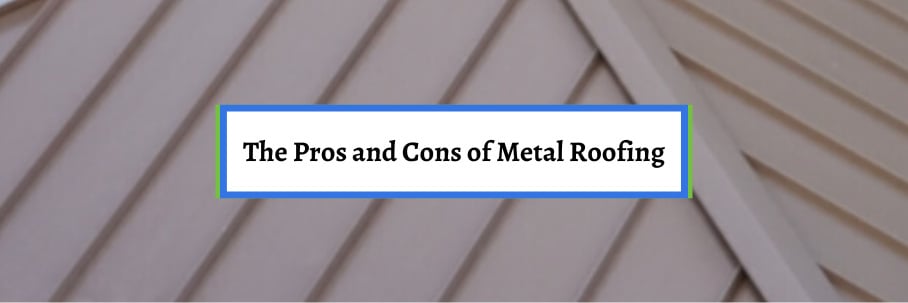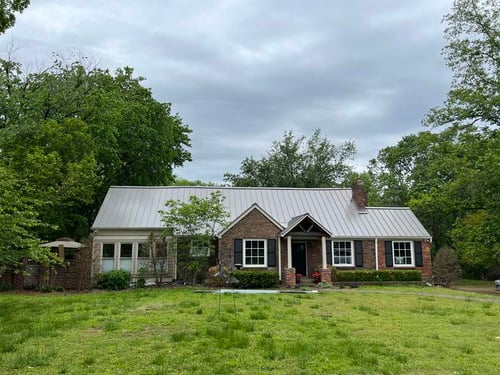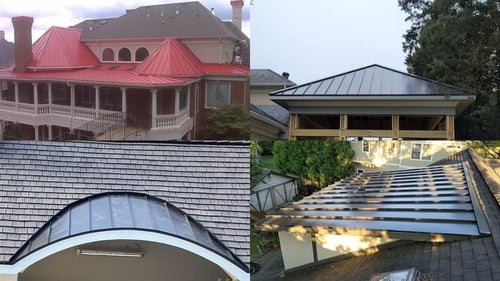The Pros and Cons of Metal Roofing

Are you interested in metal roofing? Do you need to know the good and bad to decide if it’s right for you?
Metal roofing’s popularity continues to climb in residential roofing. With this rise comes more and more homeowners considering a metal roof.
The truth is that metal roofing isn’t the right option for everyone. But the only way to figure out if it’s right for you is to learn the pros and cons.
For over 30 years, Bill Ragan Roofing has given homeowners the confidence to make the right roofing decision with simple and transparent information. So, let’s figure out if metal roofing is right for you.
First, we’ll cover the pros of metal roofing. After that, you’ll learn the cons that make homeowners avoid metal roofing.
What are the pros of metal roofing?
Let’s start with the good side of metal roofing. Below are the pros that make metal a great roofing material and why the demand for it keeps growing in residential roofing.
Metal roofing improves curb appeal
Metal roofing greatly increases your home’s curb appeal, especially a standing seam metal roof. It’s guaranteed to stand out from the standard asphalt shingle you see on most homes in the United States.
 (Standing seam metal roof)
(Standing seam metal roof)
The painted finish applied to metal panels also prevents the color you choose from fading for decades. And if you really want to stand out, premium metals like copper dramatically increase a home’s curb appeal.
I understand looks are subjective, and everyone has different tastes. However, metal roofing’s curb appeal is a big reason for its growing popularity.
The painted finish applied to metal roofing panels
I just mentioned it, but metal panels (mainly aluminum and steel) have a painted finish. This protects the color and the panels themselves from rusting or damage from everyday wear and tear.
There are different types of finishes, but steel standing seam panels come with industry-leading Kynar 500. It obviously protects the panels, but the great thing about this painted finish is the 30-year warranty.
Even better, the Kynar 500 doesn’t necessarily disappear after 30 years when the warranty expires. Just keep in mind that the specific painted finish applied to panels depends on the metal type, metal roof system, and manufacturer.
Metal roofing is long-lasting and durable
A new metal roof increases your home’s value, but the main return on investment is how long it'll last. Metal roofing is very durable, which makes it a long-lasting roofing material.
However, a metal roof’s lifespan depends on the metal roof system and metal type. Properly installed with no maintenance, a steel exposed fastener metal roof should last 20 years but can last as long as 30 years with regular maintenance.
On the other hand, a steel standing seam metal roof with a Kynar 500 painted finish will last 30 years and can get up to 50 in the right conditions. This is a great lifespan, but premium metals like copper, stainless steel, and zinc last well over 50 years.
Metal roofing is a versatile material
One of the most unique things about metal roofing is its versatility. Unlike other materials, it can be installed in plenty of places and used for accent purposes.
 (Metal roofing accents)
(Metal roofing accents)
Metal roofing is now commonly used for front porches, side porches, back porches, bay windows, and other areas to add a clean look to their asphalt roof or other roofing material. This will do a lot for your home’s curb appeal, but it won’t be cheap.
Not only are the materials expensive, but installing metal roofing is a more specialized skill set with a higher labor cost.
There are multiple metal options
Metal roofing has plenty of metal options based on budget, personal style preferences, and lifespan. However, there are certain types more commonly used in the United States.
The most common types of metal used in residential metal roofing are:
- Steel metal roofing
- Aluminum metal roofing
- Galvalume
- Copper metal roofing
- Stainless steel metal roofing
- Zinc metal roofing
While all are great options with pros and cons, the two most popular are prefinished steel and aluminum. This is mainly due to affordability, but premium metals (copper, stainless steel, and zinc) may also not be readily available in certain areas.
Metal roofing is energy-efficient
Metal roofing is an energy-efficient roofing material, mainly because of the natural reflective and emissive (releases heat quickly) properties. This helps them cool down more efficiently in hotter areas, which means using less energy (and money) to keep your home cool.
Now, darker-colored metals absorb more heat, and each metal type has different reflective properties. That’s why steel and aluminum have some kind of “cool” coating or painted finish applied to the panels.
These finishes enhance reflectivity and emissivity to meet Energy Star standards. In areas with hotter climates, this can reduce air conditioning usage by up to 25%.
What are the cons of metal roofing?
After learning why metal roofing is a great option, let’s dig into the downsides. Below are the main reasons homeowners avoid metal roofing.
Metal roofing is expensive
The biggest hurdle for metal roofing is that it’s very expensive. Metal roofing can be up to three times more expensive compared to asphalt shingles.
According to the 2025 Cost vs. Value Report, the average cost of a new metal roof is $51,865 for a prefinished steel standing seam metal roof on a 3,000-square-foot roof. Roofs come in all shapes and sizes, so it’s hard to use this average as a guideline.
However, I can give you a better idea with a rough per-square-foot cost based on the type of metal roof system.
For labor and materials, a steel exposed fastener metal roof costs around $4.50 to $6.50 per square foot. However, there will also be maintenance fees to replace the screws throughout its life.
On the other hand, a new steel standing seam metal roof costs around $16.00 per square foot. Aluminum can be cheaper or cost a little more based on availability, but premium metals get much more expensive.
Metal roofing isn’t the best option for certain climates
Metal is a great and reliable material, but climate can affect certain types of metal. So, metal roofing or a specific metal may not be the best option in certain areas.
For example, Galvanized steel is suitable for most climates in the United States. However, it performs best in areas without excessive moisture or salt exposure, which makes it a great option for landlocked or temperate regions.
On the other hand, aluminum’s natural resistance to corrosion makes it a great choice for coastal and very humid climates. However, it’s also more prone to hail and other damage in areas with frequent storms because it’s a softer metal.
Metal roofing is a great option for every corner of the United States. Just consider how your area’s climate affects the metal you’re considering.
Metal roofing can be damaged by storms
While not as prone as other roofing materials, metal roofing can get storm damage. You won’t have to worry about wind damage unless the wind gets under the metal panels.
While wind itself may not directly cause damage, fallen trees or limbs during high winds can significantly damage metal panels. On the other hand, large hail can damage metal panels and the protective painted finish (if applied).
This is especially true for copper, aluminum, and other soft metals. The good thing is that it takes a significant hail storm or prolonged exposure to frequent hail to really notice it.
Metal roofing makes noise when it rains
One of the biggest concerns homeowners (and one of the most asked questions) have is the noise metal roofing makes when it rains. You will always hear rain hitting a metal roof, but there are things you can do to help.
Ensuring there’s solid wood decking between the metal panels and your ceiling absorbs some of the noise. Wood fiber insulation boards can also be added between the decking and metal panels to help with the noise.
These boards provide an extra layer to absorb sound but won’t completely block out a heavy downpour. So, no matter what you do, just know it’s impossible to completely drown out the sound of rain when there's a heavy thunderstorm.
Which metal roof system is right for you?
After reading this article, you know the pros and cons of metal roofing. By considering the good and bad, I’m confident you can decide if metal roofing is right for you.
However, you still need to choose the type of metal roof system. I’ve mentioned them a couple of times, but there are two types of metal roofs.
While they both have their place in residential roofing, there are major differences you need to know about. Well, you need to know these differences to truly make the right decision.
That’s why I wrote another article breaking down the two metal roof systems and how they compare on key decision-making factors.
Check out Metal Roofs: Standing Seam vs. Screw Down to learn how they match on pricing, lifespan, warranties, and more.


